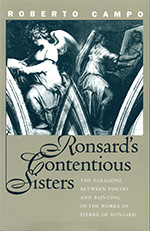
This book examines Ronsard’s participation in the heated paragone debate between poets and painters: the Renaissance contest for superiority in the ranking of the arts that emerged in counterpoint to the parity-centered, pseudo-Horatian principle of ut pictura poesis (“as is painting, so is poetry”).The book explores issues that, despite their importance throughout Ronsard’s poetry and the writings of such leading paragone theorists as Leone Battista Alberti and Leonardo da Vinci, have remained largely unnoticed. In broadest terms, it investigates the poet’s notions about the differences between poems and pictures. More precisely, it examines his views on two fundamental preoccupations of the theoretical and practical discussions about the arts during the Renaissance: which mode of expression, word or image, can more accurately and meaningfully represent natural realities and abstract celestial truths; and thus, whose art, the poet’s or the painter’s, holds the highest station in the hierarchy of human creative endeavor?